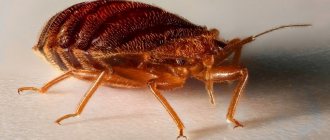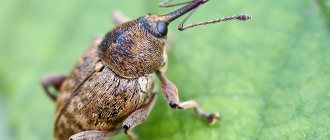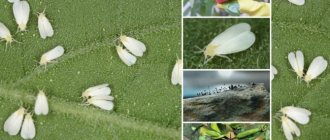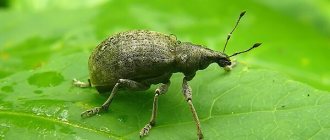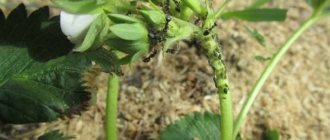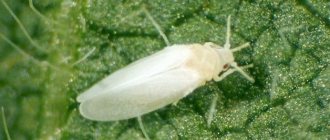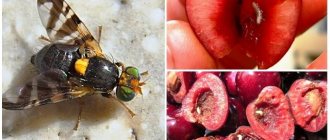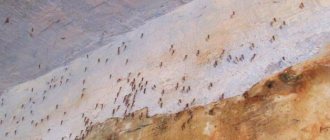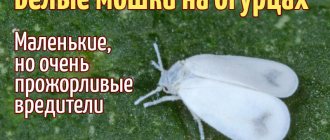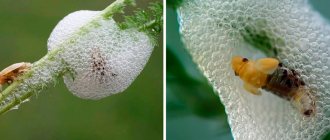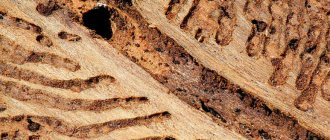The whitefly on strawberries is a pest that literally sucks out the vital juices of this plant. Therefore, when it appears on the bushes, the plantings begin to suffer: their development is slowed down, they become susceptible to diseases, and this ultimately negatively affects the taste and quantitative characteristics of the crop. Therefore, in order to get large and sweet berries, you need to start fighting whiteflies as early as possible.
Description of the pest
Representatives of whiteflies are a large class of insects, including more than 1,350 species. No more than 10 species of this pest live in Russia, and they most often feed on plants from garden beds or garden crops.
The pest got its name because of the white waxy coating on its wings. In appearance, these winged insects resemble moths. Their body is also covered with a white coating similar to flour; small yellow antennae are clearly visible on the head.
Small “moths” are no more than 5 mm in length, but they are extremely gluttonous and can quickly drink all the cell sap from an adult plant. If you do not start fighting the whitefly, it will quickly destroy the entire strawberry plantation.
The whitefly does not tolerate sunlight, so it hides on the underside of the foliage on plants. Favorable conditions for reproduction are high humidity and air temperatures above 20 degrees Celsius.
You need to know the enemy by sight!
Before moving on to ways to combat this miniature pest, it is worth getting to know it better. In Latin, their name is as follows - Aleyrodidae. They belong to representatives of insects with incomplete transformation. However, these pests are characterized by complex development. The size of the whitefly is very small - the length of the body does not exceed 1 millimeter! But due to the fact that insects settle in colonies, they can easily be seen even with the naked eye.
The whitefly survives the winter in grass that has not been harvested since the fall, and with the advent of the first warm days, the insects awaken from a long hibernation and move to the shoots and leaves of plants. And strawberries are an ideal haven for whiteflies.
Attention! For the winter, it is imperative to remove all plant remains from the area, including diseased bushes. You also need to regularly weed and remove weeds.
Only the greatest harm is caused not by adults, but by larvae that live on the underside of strawberry leaves. Their favorite diet is the life-giving juice of garden crops and tender green pulp. For this reason, some time after they settle in, small holes can be noticed on the leaves.
If previously these insects attacked the plants of gardeners in the southern regions, now colonies of pests can settle in the territory of central Russia. The climate here is moderate, with occasional frosts.
The increase in the insect's range is largely determined by the improvement in its ability to hibernate. Some individuals can wait out the cold even in open areas!
White midges are clearly visible on strawberry leaves
Varieties of whitefly
The following types of whiteflies can “settle” on garden or vegetable crops:
- Tobacco. A yellowish stripe is clearly visible on the back; the wings are located along the back. For this pest to reproduce, the temperature must be above 30 degrees Celsius.
- Citrus. It can live in the southern regions of Russia, where in winter the temperature is sufficient for it to survive. In the Moscow region and regions with similar climatic conditions, the whitefly does not survive.
- Strawberry lives exclusively in beds with strawberries and garden strawberries, as it feeds only on their cell juice.
- Cabbage takes root in cabbage beds.
- The greenhouse (or greenhouse) settles in closed ground and feeds on the cell juice of tomatoes and cucumbers, and much less often on flower plants.
Raspberry weevil (Anthonomus rubi)
If this pest appears on your site, then you should know that the threat of destruction hangs not only over strawberries, but also over raspberries and blackberries. Adult beetles are small (up to 2-3 mm in length) gray, dark or black. They cause the greatest damage to young leaves, buds and pedicels, and especially to early varieties of strawberries.
As a rule, a small number of berries, caused by the fact that the weevil has damaged the pedicels of the first buds, is mistaken by gardeners for a “crop failure.” After this, the females lay eggs in the buds, from which larvae hatch, devour the contents of the buds and pupate in them. After three weeks, their pupae emerge as adults and eat the leaves. They can be detected by long narrow passages in the leaves, and you can also see crawling insects.
Measures to combat the raspberry-strawberry weevil:
Reasons for the appearance of whiteflies on strawberries
The mass appearance of whiteflies occurs during the hottest time - July-early August. If the weather is rainy, then this is another positive factor for the development of the pest. You also need to water the strawberry beds moderately so that the water does not stagnate on the surface of the soil.
It is necessary to regularly remove weeds and excess leaves; do not use too dense materials as mulch.
These pests often love greenhouses. If they are heated, then the whitefly on strawberries can feed on cellulose juice all year round.
She feels best in dense beds with strawberries. Therefore, you should not apply too much fertilizer containing nitrogen, which provokes active growth of the vegetative mass.
Signs of parasitism and the danger of whiteflies
The main symptoms of the appearance of a pest on strawberry bushes:
- She lays eggs on the reverse side of the leaf blades; they are easy to notice if you turn the leaf. You can simply run your hand along the foliage of the bushes and you will immediately see how a cloud of small midges rises above it - these are whiteflies.
- A whitish coating appears on the leaf blades - this is whitefly secretion.
- The foliage dries out, becomes dull, and the plant begins to wither.
The main danger of the pest is that it sucks out all the cell sap from the strawberry foliage. As a result, the plants become weaker, so they can be affected by various diseases. Weakened strawberry bushes bear fruit worse, their fruits lose their taste and become small.
Strawberry mite (Tarsonemus fragariae)
These small insects cause a lot of trouble in spring and summer. And if ixodid ticks are carriers of dangerous diseases, then garden pests completely destroy plantings. In the process of development, the elusive mites acquired microscopic sizes (no more than 0.2 mm) and an inconspicuous color, which varies from translucent to yellow-brown.
It is very difficult to detect pests at the initial stage. Typically, the impact of mites can be noticed only in the second half of summer, when the leaves curl, acquire a yellowish waxy coating, wrinkle and die. The bushes become dwarf and lifeless, as mites literally suck all the juices out of the plant. Although ticks live everywhere and in regions with any climate, humid and warm zones in the north are more attractive to them than the arid and hot south. Average yield losses depending on the variety are 20-50%.
Measures to combat strawberry mites:
Insect control methods
Whiteflies can be controlled in different ways:
- using chemicals;
- biological methods;
- using folk remedies.
Chemicals
Many insecticidal preparations are effective against whiteflies, which can be purchased at any gardening store.:
- Aktara . The drug is packaged in sachets of 4 and 250 g. This insecticide is diluted as follows: 4 g of the product are dissolved in 4 liters of water. The resulting liquid is sprayed onto the vegetative mass of strawberries, as well as the soil in the beds.
- Aktellik . The drug is available in ampoules. Typically, the effect of the drug begins three days after spraying. During the season, strawberries can be treated with the solution no more than 4 times.
- Rovikurt . Insecticide in the form of an oily liquid. It should be used if the strawberry plantation is almost completely affected by whitefly. The drug is diluted as follows: 10 g of product per bucket of water.
- Pegasus . It goes on sale in ampoules. Prepare the working fluid as follows: 10 ml of product per 5 liters of water. Strawberry bushes are treated twice per season, with the interval between spraying being 6-8 days.
- Verticillin J. To spray, you need to prepare a solution: dilute 50 ml of product in 2 liters of water.
Anti-moth tablets
To treat strawberry bushes, prepare a solution according to the following scheme: dissolve 5 tablets of the drug in 5 liters of water.
Chemical treatments should be carried out several times a season, since one spraying is not enough to completely destroy the pest. The final treatment is carried out about a couple of weeks before or after harvest.
Biological methods
The most effective biological method of controlling whiteflies is the use of its natural enemies - insect predators: encarsia and macrophus bugs. These predators do not feed on foliage or plant cell sap, but do eat whitefly eggs. After there is no food left for predators on the plants, they leave the strawberry bushes and move to other areas.
Folk recipes
Chemicals are toxic and can accumulate in the foliage and fruits of strawberries and cause harm to the human body. Therefore, they are used in cases where the whitefly colony has grown too large.
If there are few insects, then it is better to use traditional methods to combat it.
The most effective of them are:
- Garlic tincture . Grate 300 g of garlic cloves on a coarse grater, add hot liquid and leave for 6-8 days, shaking the mixture daily. Then the infusion is filtered and diluted with water in the following proportion: 20 ml per 2 liters of water.
- Soap solution . Dissolve a bar of laundry soap in 10 liters of water and treat the strawberry shoots and foliage. This method is the safest and quite effective.
- Peppermint . To scare away this flying pest from a strawberry plantation, peppermint is planted between the rows, the smell of which repels the whitefly.
- Decoction of lemon peels . The peels are cut off from 20 lemons and boiled in 5 liters of water. After the broth has cooled, it is filtered and sprayed on the strawberries regularly once every 3 days. But this method is not the most effective.
Biological method
Fighting the winged pest of strawberries using biomaterial is a worthy alternative to the chemical method. The biological method consists of the deliberate settlement of macrolophus or encarsia bugs in berry beds, which feed on whitefly larvae without causing any harm to the green spaces. Having completed their mission, the cleaning bugs move on to another location. You can buy such biological material in large garden farms or laboratories.
An equally effective biological agent is the drug "Verticillin Zh", which contains fungal spores. Having penetrated the insect's body, the fungus attacks its organs and leads to death.
Timing and schemes for processing strawberry bushes
Rules for treating strawberries against whiteflies:
- Before processing, strawberry foliage is sprayed with hot water, the temperature of which should be about 39 degrees. After the leaf plates have dried, spraying can be carried out.
- The working fluid for processing strawberries should be prepared in advance.
- The bushes of this berry crop are sprayed with a spray bottle.
- Treatment of strawberry plantations is carried out several times with an interval of 6-8 days, since all products act only on adult individuals or their larvae, but not on eggs laid by females.
- Chemicals should be changed, as they can be addictive to the pest.
What remedies helped you get rid of whiteflies?
Folk
Chemical
Strawberry nematode (Aphelenchoides Fragariae)
Nematodes are incredibly voracious and tenacious worms that feed on all vegetable and berry crops. Detecting a roundworm up to 1 mm long is not easy. Especially considering that it prefers to settle in the buds and axils of leaves. However, the nematode can hide in the soil for a long time and successfully withstand both adverse weather conditions and various chemicals.
Nematodes cause deformation and rotting of buds, ovaries and flowers. They curl and wither, the bushes stop growing, become dwarf and sometimes may not produce berries at all. The leaf petioles turn red, lose their pubescence and become thinner. The leaf blades darken and feel like leather to the touch. It is believed that the Festivalnaya variety is relatively resistant to nematodes, and strawberry bushes of varieties such as Krasavitsa Zagorya and Rannyaya Makheraukha can lose up to 75% of the harvest.
Measures to combat strawberry nematode:
Preventive actions
In the fight against whitefly, the main thing is to carry out a number of preventive measures to prevent its appearance:
- periodically treat strawberry bushes with insecticidal agents against pests;
- inspect the foliage to detect the appearance of insects in time;
- when growing strawberries in greenhouse conditions, regularly ventilate the greenhouses;
- Weed the beds in a timely manner and remove all weeds.
It is important to carry out preventive measures aimed at preventing the appearance of the pest on strawberries. If “harmful” bugs have already appeared on the leaves, then it is necessary to begin treatment. The main thing is to notice these small flying insects in time and start fighting them.
Prevention
For prevention, the following steps should be taken:
- regularly spray against whiteflies;
- monitor their appearance on the leaves;
- if strawberries grow in a greenhouse, then ensure good ventilation;
- removing weeds and plants that have dried out in a timely manner will help prevent the appearance of insects on the plantation as a whole.
Important! Removing the insect by hand is less effective than spraying.
If all these rules are followed, it is possible to achieve complete extermination of whiteflies, as well as prevent their appearance on plantations. The main thing is to notice it in time and start fighting.
